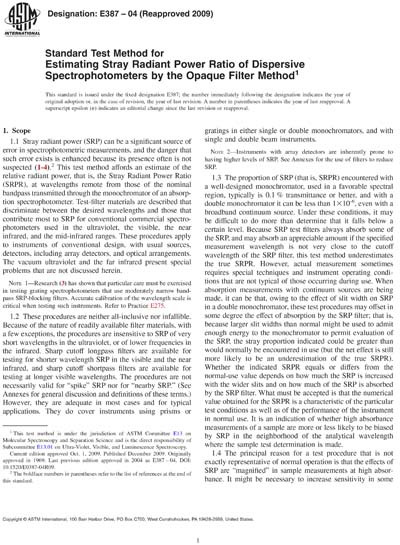Historical
ASTM E387-04(2009)
Standard Test Method for Estimating Stray Radiant Power Ratio of Dispersive Spectrophotometers by the Opaque Filter Method
1.1 Stray radiant power (SRP) can be a significant source of error in spectrophotometric measurements, and the danger that such error exists is enhanced because its presence often is not suspected (1-4). This test method affords an estimate of the relative radiant power, that is, the Stray Radiant Power Ratio (SRPR), at wavelengths remote from those of the nominal bandpass transmitted through the monochromator of an absorption spectrophotometer. Test-filter materials are described that discriminate between the desired wavelengths and those that contribute most to SRP for conventional commercial spectrophotometers used in the ultraviolet, the visible, the near infrared, and the mid-infrared ranges. These procedures apply to instruments of conventional design, with usual sources, detectors, including array detectors, and optical arrangements. The vacuum ultraviolet and the far infrared present special problems that are not discussed herein.
Note 1—Research (3) has shown that particular care must be exercised in testing grating spectrophotometers that use moderately narrow bandpass SRP-blocking filters. Accurate calibration of the wavelength scale is critical when testing such instruments. Refer to Practice E275.
1.2 These procedures are neither all-inclusive nor infallible. Because of the nature of readily available filter materials, with a few exceptions, the procedures are insensitive to SRP of very short wavelengths in the ultraviolet, or of lower frequencies in the infrared. Sharp cutoff longpass filters are available for testing for shorter wavelength SRP in the visible and the near infrared, and sharp cutoff shortpass filters are available for testing at longer visible wavelengths. The procedures are not necessarily valid for “spike” SRP nor for “nearby SRP.” (See Annexes for general discussion and definitions of these terms.) However, they are adequate in most cases and for typical applications. They do cover instruments using prisms or gratings in either single or double monochromators, and with single and double beam instruments.
Note 2—Instruments with array detectors are inherently prone to having higher levels of SRP. See Annexes for the use of filters to reduce SRP.
1.3 The proportion of SRP (that is, SRPR) encountered with a well-designed monochromator, used in a favorable spectral region, typically is 0.1 % transmittance or better, and with a double monochromator it can be less than 1×10-6, even with a broadband continuum source. Under these conditions, it may be difficult to do more than determine that it falls below a certain level. Because SRP test filters always absorb some of the SRP, and may absorb an appreciable amount if the specified measurement wavelength is not very close to the cutoff wavelength of the SRP filter, this test method underestimates the true SRPR. However, actual measurement sometimes requires special techniques and instrument operating conditions that are not typical of those occurring during use. When absorption measurements with continuum sources are being made, it can be that, owing to the effect of slit width on SRP in a double monochromator, these test procedures may offset in some degree the effect of absorption by the SRP filter; that is, because larger slit widths than normal might be used to admit enough energy to the monochromator to permit evaluation of the SRP, the stray proportion indicated could be greater than would normally be encountered in use (but the net effect is still more likely to be an underestimation of the true SRPR). Whether the indicated SRPR equals or differs from the normal-use value depends on how much the SRP is increased with the wider slits and on how much of the SRP is absorbed by the SRP filter. What must be accepted is that the numerical value obtained for the SRPR is a characteristic of the particular test conditions as well as of the performance of the instrument in normal use. It is an indication of whether high absorbance measurements of a sample are more or less likely to be biased by SRP in the neighborhood of the analytical wavelength where the sample test determination is made.
1.4 The principal reason for a test procedure that is not exactly representative of normal operation is that the effects of SRP are “magnified” in sample measurements at high absorbance. It might be necessary to increase sensitivity in some way during the test in order to evaluate the SRP adequately. This can be accomplished by increasing slit width and so obtaining sufficient energy to allow meaningful measurement of the SRP after the monochromatic energy has been removed by the SRP filter. However, some instruments automatically increase sensitivity by increasing dynode voltages of the photomultiplier detector. This is particularly true of high-end double monochromator instruments in their ultraviolet and visible ranges. A further reason for increasing energy or sensitivity can be that many instruments have only absorbance scales, which obviously do not extend to zero transmittance. Even a SRP-proportion as large as 1 % may fall outside the measurement range.
Note 3—Instruments that have built-in optical attenuators to balance sample absorption may make relatively inaccurate measurements below 10 % transmittance, because of poor attenuator linearity. The spectrophotometer manufacturer should be consulted on how to calibrate transmittance of the attenuator at such lower level of transmittance.
1.5 High accuracy in SRP measurement is not always required; a measurement reliable within 10 or 20 % may be sufficient. However, regulatory requirements, or the needs of a particular analysis, may require much higher accuracy. Painstaking measurements are always desirable.
1.6 The values stated in SI units are to be regarded as standard. No other units of measurement are included in this standard.
1.7 This standard does not purport to address all of the safety concerns, if any, associated with its use. It is the responsibility of the user of this standard to establish appropriate safety and health practices and determine the applicability of regulatory limitations prior to use.
ASTM International [astm]

